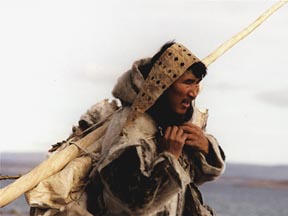FILM REVIEW ATANARJUAT. The Fast Runner.
MAYA
KHANKHOJE
Directed by Zacharias Kunuk
--------------------------------------------------------------------------------
Zacharias Kunuk is one of the world's most widely respected Aboriginal filmmakers. His award-winning productions have been shown in 16 countries, from Peru to Taiwan. His credits include the ground-breaking Qaggiq (Gathering Place, 1989), Nunaqpa (Going Inland, 1991), Saputi (Fish Traps, 1993), the series Nunavut (Our Land, 1995), and the documentaries Arvik (Bowhead, 1998) and Nipi (Voice, 1999).
Canada's first feature film written, produced, directed and acted by Inuit in their own language, Inuktitut, was also Canada's first film nominated for a Foreign Language Oscar. It won Canada's first Camera d'Or from Cannes for the best feature film, as well as the winner of a dozen or so additional awards. Another characteristic of this film is that it is a genre-bender, an unselfconscious amalgam of documentary cinematography, soap opera characterization and powerful visual narrative. It can be enjoyed as an exciting action thriller set in the frozen landscape of Iglook, the Eastern Canadian Arctic , as a stunningly beautiful icescape that is as timeless as it is otherworldly, as a recreation of pre-colonial aboriginal life and as a cautionary tale warning us of the dangers of putting personal desire before community needs.

Atanarjuat is an unusual film in many other ways. It is perhaps the first serious cinematographic look at the Inuit community from an Inuit perspective, a very important achievement for a people whose culture, needs and aspirations have been traditionally mediated by others. It closes the circle that was opened by Robert Flaherty in 1922 in his portrait of Inuit life in Nanook of the North. The manner in which the film was produced is also a first. Zacharias Kunuk and his partners established a cooperative production company called Suma which loosely translates as "mind" or "thought", whose profits are ploughed back into the community. Not surprisingly, the filming process required support from the whole community: the elders voiced their opinions on how the different characters should act, the actors were members of the community, the women recreated the period costumes required (the film is roughly set in the 16th Century) and other members ensured that no snowmobile tracks marred the pristine snow of the location.
Atanarjuat is based on the traditional story of a naked runner who had to flee for his life across the ice, as told by Kunuk's mother and later embellished by the film team. The main protagonists are Atanarjuat and Oki, childhood friends who end up playing out their inherited feud, all for the love of Atuat, who had been promised to Oki as a child but who chose Atanarjuat as an adult. It is a story of love, jealousy, greed, murder, revenge and the never-ending cycle of hatred and dysfunction that ensued. It corroborates the fact that hatred and jealousy are as easily handed down through the generations as are wisdom and knowledge. It speaks to faith in people and their inherent capacity for solving problems by consensus building rather than by a punitive justice system that can only perpetuate violence without serving any social aim.
Because violence does rear its ugly head in Atanarjuat, which is by no means an idealized portrait of a "primitive" people, but rather a complex depiction of a nomadic form of life in a hostile milieu that brings out both the best and the worst in people, but which in the end fosters certain forms of cooperative behaviour for its own survival.

Zacharias Kunuk, the main film producer, was born into a family of 13 children, and into a generation of young people who were forced off the land and placed into settlements for government schooling. His first calling had been sculpture but he later turned to video filming, a very important medium for indigenous artists. He worked for the Inuit Broadcasting Corporation -controlled from Ottawa- for some years before setting up his own production company. His main body of work is a 13-part programme called Nunavut, set in the forties, before the Canadian government took drastic steps to make the nomadic Inuit settle down. We could say that Nunavut is a postcolonial depiction of Inuit life, whereas Atanarjuat, whilst leaping into the pre-colonial past, is actually jumping into the future by giving us a model for cultural reappropriation in Nunavut after its political emergence.
Just as Kunuk turned to the past for a vision of the future, it is natural that he should have filmed Atanarjuat, The Fast Runner, in video and then transferred it to the wide screen, with stunning results. But a word of warning: do not wait for the video version of this film: it is worth all the aggravation of movie plexes with their surround cacophony, popcorn-littered aisles and gummed-up plush seats. It is worth all that sacrifice and more, for only a state-of-the art movie theater can faithfully capture the wide-angle majesty of the frozen Arctic and the not-to-be-forgotten haunting and enthralling musical score which springs from the deepest of the deepest voices of Inuit throat singers.
Run fast . . . now . . . to the nearest movie theatre, before your resolve freezes over.
THE END